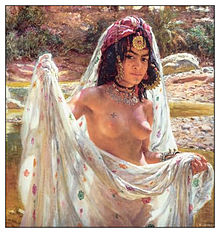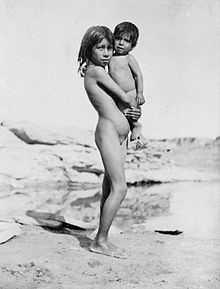- Depictions of nudity
-
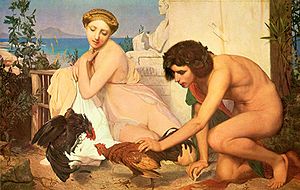 Nudity was acceptable to the 19th-century French Salon-going public, only as long as the setting was clearly "classical", depicting characters in a culture where nudity was commonplace, as in this painting by Jean-Léon Gérôme (1847).
Nudity was acceptable to the 19th-century French Salon-going public, only as long as the setting was clearly "classical", depicting characters in a culture where nudity was commonplace, as in this painting by Jean-Léon Gérôme (1847).
Depictions of nudity refers to nudity in all the artistic disciplines including vernacular and historical depictions. Nudity in art has generally reflected — with some exceptions — social standards of aesthetics and modesty/morality of their time in painting, sculpture and more recently in photography.
At all times in human history, the human body has been one of the principal subjects for artists. It has been represented on prehistoric paintings and statutes and in all eras since. The male nude was more common in antiquity, especially in ancient Greece, but today the tendency is for the female nude body to be more highly regarded and represented.
Since the first days of photography, the nude was a source of inspiration for those that adopted the new medium. Most of the early images have been closely guarded or surreptitiously circulated, on account of social norms of the time. At that time, prostitutes tended to model for these photographs. Today, the images of the human body are often, especially in advertising for the wide variety of products and services, those of the female body.
Many cultures accept nudity in art even when they shun actual nudity. For example, even an art gallery which exhibits nude paintings will typically not accept nudity of a visitor.
Contents
General depictions
 The Moscophoros of the Acropolis, ca 570 BCE. A youth bearing a calf to sacrifice is depicted in full frontal nudity, yet he is partly clothed with a ceremonial cloth that covers his back, upper arms and front thighs.
The Moscophoros of the Acropolis, ca 570 BCE. A youth bearing a calf to sacrifice is depicted in full frontal nudity, yet he is partly clothed with a ceremonial cloth that covers his back, upper arms and front thighs.
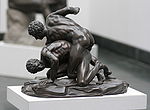 A bronze smaller reproduction in Munich of the Roman marble.
A bronze smaller reproduction in Munich of the Roman marble.
As social attitudes about artistic nudity have changed, this has sometimes led to conflict over art that no longer conforms to prevailing standards of what is acceptable. For example, some members of the Roman Catholic Church once organized the so-called "fig-leaf campaign" to cover nudity in art, starting from the works of Renaissance artist Michelangelo, but the Church has since removed such fig leaves and restored the works.[citation needed] In contrast, it was conventional in ancient Greek art, from the time of the Archaic period onwards, to represent deities and divinized humans (or "heroes") in a state of heroic nudity in paintings and sculpture, and it remained so throughout the classical and Roman periods.
Even though tastes changed significantly, semi-nude themes kept their attraction, even leading to copying of scenes from many centuries before.
Genres
The nude has become an enduring genre and theme of representational art, especially painting, sculpture and photography. It depicts people without clothes, usually with stylistic and staging conventions that distinguish the artistic elements (such as innocence, or similar theatrical/artistic elements) of being nude with the more provocative state of being naked. A nude figure is one, such as a goddess or a man in ancient Greece, for whom the lack of clothing is its usual condition, so that there is no sexual suggestiveness presumed. A naked figure is one, such as a contemporary prostitute or a businessman, who usually wears clothing, such that their lack of it in this scene implies sexual activity or suggestiveness (See also: nudity and sexuality). The latter were rare in European art from the Medieval period until the latter half of the 1800s; in the interim, a work featuring an unclothed woman would routinely identify her as "Venus" or another Greco-Roman goddess, to justify her nudity. There can be debate with regard to whether a figure in art is either nude or naked for example in some works of Francis Bacon.
Representations
Nudity in art, also publicly displayed, is rather common and more accepted than public nudity of real people. For example, a statue or painting representing a nude person may be displayed in public places where actual nudity is not allowed. However, there is also much art depicting a nude person with a piece of cloth or other object seemingly by chance covering the genitals. Some feel the selected focus of "Nude studies" lends itself to an impersonal, objectifying depiction of the human body; others say it can be as selectively depicted as a landscape.
In satire and media
A 1960s comedy sketch featuring English comedians Peter Cook and Dudley Moore admiring Cézanne's Les Grandes Baigneuses in the National Gallery humorously suggested that there must be hundreds of paintings that are not publicly displayed because the pieces of cloth did not fall in just the right places while the artist was painting them.
In modern media, images of partial and full nudity are used in advertising to draw additional attention. In the case of attractive models this attention is due to the visual pleasure the images provide; in other cases it is due to the relative rarity of images of nudity. The use of nudity in advertising tends to be carefully controlled to avoid the impression that the company whose product is being advertised is indecent or unrefined. There are also (self-imposed) limits on what advertising media such as magazines allow. The success of sexually provocative advertising is claimed in the truism "sex sells". However, responses to nudity in American advertisements have been more mixed; nudity in the advertisements of Calvin Klein, Benetton, and Abercrombie & Fitch, to name three companies, have provoked much negative as well as positive response. (See also: Sex in advertising).
Of images of nudity (not necessarily pornographic), the most extreme form is full frontal nudity, referring to the fact that the actor or model is presented from the front and with the genitals exposed. Frequently images of nude people do not go that far and photos are deliberately composed, and films edited, such that in particular no genitalia are seen, as if the camera failed to see them by chance. This is sometimes called "implied nudity" as opposed to "explicit nudity."
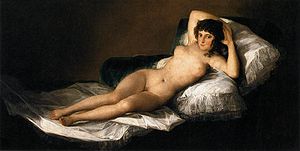

Goya's La maja desnuda and La maja vestida. Goya painted La maja vestida after outrage in Spanish society over the previous Desnuda. Without a pretense to allegorical or mythological meaning, the painting was "the first totally profane life-size female nude in Western art".[1] He refused to paint clothes on her, and instead created a new painting. Film and television
The portrayal of nudity in motion pictures and television has long been controversial. Full nudity has gained much wider acceptance in European cinema and television where, in contrast to their US counterparts, the audience perceive nudity and sexuality in general as less objectionable than the depiction of violence. Nudity in a sexual but non-pornographic context, however, has in many European countries remained on the fringe of what is socially acceptable for public shows, although this situation was liberalized during the later 20th century; in the 1970s Australian soap operas Number 96 and The Box regularly included nudity, and in the Netherlands nudity has been featured on talk shows such as Jensen! and Giel, starring Giel Beelen.
Broadcast television and most "basic cable" outlets in the United States have been more reluctant to display nudity in most cases, the exception being PBS. A few series in the 1990s, including NYPD Blue, have occasionally used partial nudity, both male and female. When broadcast on television, theatrically released films featuring nudity are usually presented with the nude scenes edited out, or the nudity is obscured in some fashion (for example digital imagery may be used to clothe nude actors). Several premium cable services such as HBO, Showtime, and more recently FX, have gained popularity for, among other things, presenting unedited films. In addition, they have produced series that do not shy away from nude scenes, including Oz, Sex and the City, The Sopranos, True Blood, and Queer as Folk (the British original was pioneering even in the more tolerant U.K.). Big Brother (TV series), which has shot in multiple countries, sometimes has nudity in the show, however, the scenes with nudity do not always air on TV.
Ethnographic nudity
This tentatively called "ethnographic" nudity has appeared both in serious research works on ethnography and anthropology, as well as in commercial documentaries and in the National Geographic magazine in the United States. In some cases, media outlets may show nudity which occurs in a "natural" or spontaneous setting in news programs or documentaries, while blurring out or censoring the nudity in a dramatic work.
The ethnographic focus provided an exceptional framework for painters and photographers to depict peoples whose nudity was, or still is, acceptable within the mores, or within certain specific settings, of their traditional culture.[2]
Detractors of ethnographic nudity often dismiss it as mere colonial gaze preserved as "ethnographic" imagery. However, the works of some ethnographic painters and photographers, like Irving Penn, Casimir Zagourski,[3] Hugo Bernatzik and Leni Riefenstahl, have received worldwide acclaim for preserving what is perceived as a documentation of the dying mores of "paradises" subjecty to the onslaught of average modernity.[4]
American Art media continues to report on depictions of nudity in the US culture as artists flock to work from live nude models and the internet has increased both interest and awareness. For example, ARTnews: "Nothing Like the Real Thing"[5] and The New York Observer: "As the Flesh Fades, NY Painters Band Together" [6]
Other depictions in vernacular culture
Nudity is occasionally presented in other media as well (often with attending controversy) such as on album covers featuring music by performers such as Jimi Hendrix, John Lennon and Yoko Ono, Nirvana, Blind Faith, Scorpions and Jane's Addiction. Several rock musicians have performed nude on stage, including members of Jane's Addiction, Rage Against the Machine, Green Day, Black Sabbath, Stone Temple Pilots, The Jesus Lizard, Blind Melon, Red Hot Chili Peppers, blink-182, Queens of the Stone Age, Of Montreal, and The Bravery.
Television soap operas have rarely shown any risqué nudity, the exception being the Procter & Gamble soap operas As the World Turns and Guiding Light which in 2005 went as far as featuring rear male nudity during lovemaking scenes. After the Janet Jackson Super Bowl XXXVIII halftime show controversy in February 2004, U.S. Federal Communications Commission commissioner Michael J. Copps stated that it was time for a crackdown on daytime television and indicated that he was reviewing whether soap operas were violating the agency's indecency prohibitions. Following this news, Guiding Light edited out nudity from an episode that had already been taped. A week later, the show's executive producer John Conboy was fired and replaced by Ellen Wheeler. All nine American network soaps began to impose an unwritten rule of avoiding any sort of risqué adult scenes.
An example of an advertisement featuring male full frontal nudity is one for M7 fragrance. Many magazines refused to place the ad, so there was also a version with a more modest photograph of the same model.
On the Internet, especially on websites featuring images of well known people, the terms nude and nudity have often been used (some would say misused) to signify indecent exposure; for example, a photo of an otherwise fully clothed woman with a nipple exposed. See also: Nude celebrities on the Internet.
In the early 1990s, Demi Moore became a pop culture icon in part because of two nude photos that she posed for in Vanity Fair: More Demi Moore and Demi's Birthday Suit.
Children as subjects
 Henry Scott Tuke, The Bathers (1885)
Henry Scott Tuke, The Bathers (1885)
During the Italian Renaissance, nude young boys were featured in many paintings, especially those with a Christian theme. Raphael, for example, made paintings of nude putti, sometimes incorrectly identified as cherubim. Other famous examples are Amor Vincit Omnia by Caravaggio and various portraits of Jesus as a baby. Centuries later, many painters created images of nude children that carried no religious significance. For instance, Henry Scott Tuke painted nude adolescent boys doing everyday activities; his images were not overtly erotic, nor did they usually show their genitals.[citation needed] Otto Lohmüller became controversial for his nude paintings of young males, which often depicted genitals. Balthus and William-Adolphe Bouguereau included nude girls in many of their paintings.
Some sculptures depict nude child figures. A particularly famous one is Manneken Pis in Brussels showing a nude young boy urinating into the fountain below. Jeune nymphe descendant dans l'eau (1824) by Georges Jacquot shows a seated nude prepubescent girl.
Professional photographers such as Jock Sturges, Sally Mann, David Hamilton, Jacques Bourboulon, Garo Aida, and Bill Henson have made photographs of nude children and adolescents for publication in books and magazines and for public exhibition in art galleries. According to one school of thought, photographs such as these are acceptable and should be (or remain) legal since they represent the unclothed form of the children in an artistic manner, the children were not sexually abused, and the photographers obtained written permission from the parents or guardians. Opponents suggest that such works should be (or remain) banned and represent a form of child pornography, involving subjects who may have experienced psychological harm during or after their creation. Sturges and Hamilton were both investigated following public condemnation of their work by Christian activists including Randall Terry. Several attempts to prosecute Sturges or bookseller Barnes and Noble have been dropped or thrown out of court and Sturges's work appears in many museums, including New York's Metropolitan Museum of Art[7][8][9]
The provocative photo of a nude prepubescent girl on the original cover of the Virgin Killer album by the Scorpions also brought controversy. By contrast, most would consider the naked male baby shown on the cover of the Nevermind album by Nirvana to have no sexual connotation[citation needed].
There have been incidents in which snapshots taken by parents of their infant or toddler children bathing or otherwise naked were destroyed or turned over to law enforcement as child pornography.[10] Such incidents may be examples of false allegation of child sexual abuse and the overzealous prosecution of such cases has been described in terms of a moral panic surrounding child sexual abuse and child pornography.[11]
See also
Wikimedia Commons has media related to: - Art nude
- Guerrilla Girls, a feminist group challenging predominance of female nudity in the arts.
- Iconography
- Leda and the Swan
- Nude photography
- Nudity in American television
- Nudity in film
- Pubic hair in art
References
- ^ Licht, Fred, page 83, 1979.
- ^ Casimir Zagourski "L'Afrique Qui Disparait" (Disappearing Africa)
- ^ C. Spieser & P. Sprumont, La construction de l’image du corps de l’élite égyptienne à l’époque amarnienne (The formulation of body image for the Egyptian elite in the Amarna period)
- ^ Michael Hoppen Gallery - Artist - Hugo Bernatzik
- ^ [http://www.artnews.com/2010/12/01/nothing-like-the-real-thing/
- ^ [http://www.observer.com/2011/culture/flesh-fad-fades-nude-painters-band-together
- ^ Doherty, Brian (May, 1998). "Photo flap - campaign against authors Jock Sturges and David Hamilton". http://findarticles.com/p/articles/mi_m1568/is_n1_v30/ai_20529211/.
- ^ "Obscenity Case Is Settled". The New York Times. May 19, 1998. http://www.nytimes.com/1998/05/19/us/obscenity-case-is-settled.html?src=pm.
- ^ "Panel Rejects Pornography Case". The New York Times. Sept 15, 1991. http://www.nytimes.com/1991/09/15/us/panel-rejects-pornography-case.html?src=pm.
- ^ Kincaid, James R.. "Is this child pornography?". http://archive.salon.com/mwt/feature/2000/01/31/kincaid/index.html. Retrieved 2007-04-28.
- ^ Peron, Jim (May 5, 2003). Zola, Emile. ed. "The Claptrap over Child Pornography". The Laissez Faire Electronic Times (Digital Monetary Trust) 2 (18). http://freedom.orlingrabbe.com/lfetimes/kiddie_porn1.htm. Retrieved 27-08-2011.
Categories:
Wikimedia Foundation. 2010.




